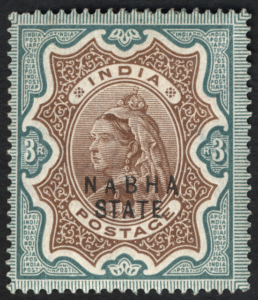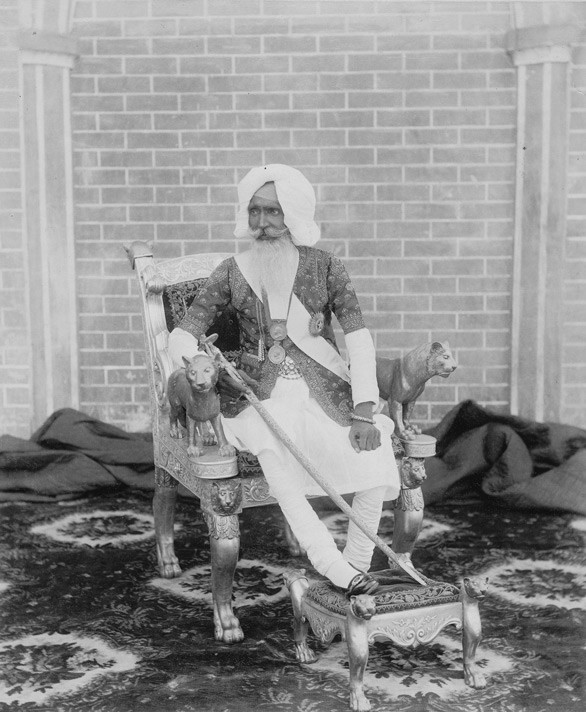
The princely state of Nabha, nestled within the Punjab region of pre-independence India, holds a unique place in the world of philately. As one of the Indian Convention States, Nabha was part of a rare postal arrangement that granted it the privilege to issue its own postage stamps—stamps that continue to captivate collectors today with their hybrid blend of local rule and British imperial design.
What Are the Indian Convention States?
Before India’s independence in 1947, the subcontinent was divided into two primary administrative categories: British India and Princely States. The latter were nominally sovereign but under British suzerainty. Among the princely states, five entered into special agreements with the British Raj known as Postal Conventions, allowing them to use British India’s postage stamps overprinted with the name of the respective state. These were:
-
Chamba
-
Faridkot
-
Gwalior
-
Jind
-
Nabha
These states are collectively referred to as the Indian Convention States—distinct from the Feudatory States, which issued entirely independent designs.
Nabha: A Brief Historical Snapshot
The State of Nabha was founded in the 18th century and became a British protectorate in 1809. Governed by the Phulkian dynasty, Nabha was a relatively small but influential state located in the eastern Punjab region. Its rulers were loyal allies of the British, and in return, they were granted honors and administrative privileges—one of which was participation in the postal convention system.
Postal History of Nabha
The First Overprints
Nabha began using overprinted British Indian stamps in 1885. These stamps bore the inscription “NABHA STATE” and were generally identical in design to regular British Indian issues, such as the Victoria definitives, but with the additional local overprint. This overprint signified that the postage had been officially sanctioned for use within Nabha.
The early overprints were created on Queen Victoria issues, including:
-
Half Anna blue-green
-
One Anna brown
-
Two Annas violet
Design and Production
These overprints were applied by the India Security Press in Nasik, ensuring a uniform appearance and centralized control. However, numerous varieties exist—ranging from shifts in the overprint, typographic inconsistencies, to forged examples, which make Nabha stamps a rewarding area of study for specialists.
Later Issues
Nabha continued issuing overprinted stamps through the reigns of Edward VII, George V, and George VI. Each monarch’s portrait series was overprinted for use in Nabha, producing a wide array of denominations and colors.
During this time, Nabha also issued official service stamps—marked with “SERVICE” in addition to “NABHA STATE”—for use by government offices.
End of the Nabha Stamps
With India’s independence in 1947, the separate postal systems of the Convention States were gradually integrated into the national postal network. Nabha stamps were demonetized, and by 1950, Indian Republic stamps had fully replaced the regional issues. However, their legacy endures in philatelic collections around the globe.
Why Collect Nabha Stamps?
Collectors are drawn to Nabha stamps for several reasons:
-
Historical context: They represent a colonial-era postal system where Indian states operated semi-autonomously.
-
Overprint studies: Numerous font styles, errors, and typographic shifts exist.
-
Affordability: Many Nabha stamps remain accessible to entry-level collectors.
-
Specialist appeal: For advanced philatelists, research into postal rates, cancellations, and postal history of Nabha offers rich investigative terrain.
Notable Variations and Forgeries
As with many Convention States, forgeries of Nabha overprints abound. Some forgeries are crude, while others require close inspection of font style, ink type, and alignment. Consulting authoritative references and expertizing stamps is often necessary for high-value items.
Nabha and the Universal Postal Union (UPU)
Although Nabha did not directly join the Universal Postal Union, its integration into the British Indian postal network ensured that international mail from Nabha adhered to UPU standards. The overprinted stamps were valid for postage across India and internationally—further solidifying their role in global mail circulation.
List of the Issued Postage Stamps:
1.07.1885 Queen Victoria. Optd with T 1.
1.11.1885 Optd with T 2.
(a) In red.
(b) In black (Nov 1885-97).
(c) New value. In black (Nov 1900).
1.01.1903 King Edward VII. Optd with T 2.
1.01.1907 Nos. 149/50 of lndia optd with T 2.
1.01.1913 Maharaja Ripudaman (Gurcharan) Singh, 1911-1928. King George V. Optd with T 2.
1.01.1924 As 1913. New colour.
1.01.1927 King George V (Nasik printing, wmk Mult Star), optdas T 3 or 4 (rupee values).
1.01.1936 Maharaja Partab Singh, 1928-1971. New types and colours. Optd as T 3.
1.01.1938 King George VI. Nos. 247/64 optd as T 3 (3 p. to 1 a.), T 5 (2 a. to 12 a.) or T 4 (rupee values). W 69 (inverted on 15 r.).
1.01.1941 King George VI. Optd with T 6.
(a) Stamps of 1937.
(b) Stamps of 1940-43.


